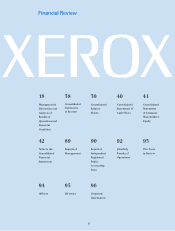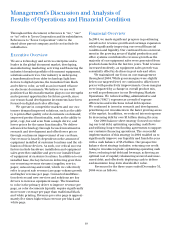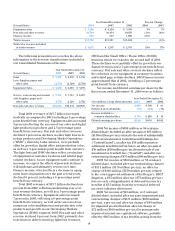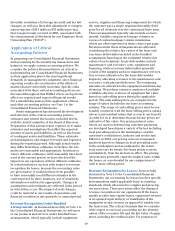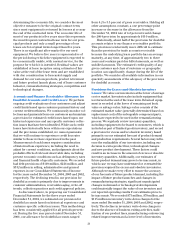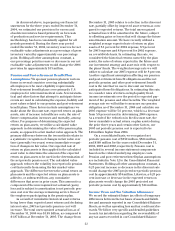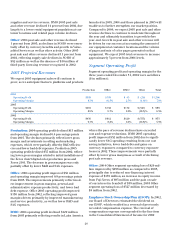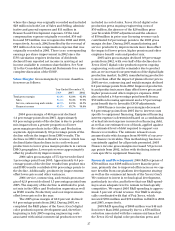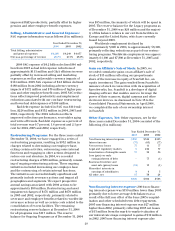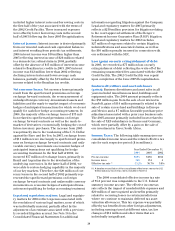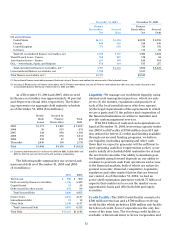Xerox 2004 Annual Report Download - page 24
Download and view the complete annual report
Please find page 24 of the 2004 Xerox annual report below. You can navigate through the pages in the report by either clicking on the pages listed below, or by using the keyword search tool below to find specific information within the annual report.
22
As discussed above, in preparing our financial
statements for the three years ended December 31,
2004, we estimated our provision for excess and
obsolete inventories based primarily on forecasts
of production and service requirements. This
methodology has been consistently applied for all
periods presented. During the three year period
ended December 31, 2004, inventory reserves for net
realizable value adjustments as a percentage of gross
inventory varied by approximately one percentage
point. Holding all other assumptions constant, a
one percentage point increase or decrease in our net
realizable value adjustments would change the 2004
provision by approximately $13 million.
Pension and Post-retirement Benefit Plan
Assumptions: We sponsor pension plans in various
forms in several countries covering substantially
all employees who meet eligibility requirements.
Post-retirement benefit plans cover primarily U.S.
employees for retirement medical costs. Several statis-
tical and other factors that attempt to anticipate future
events are used in calculating the expense, liability and
asset values related to our pension and post-retirement
benefitplans. These factors include assumptions we
make about the discount rate, expected return on plan
assets, rate of increase in healthcare costs, the rate of
future compensation increases and mortality, among
others. For purposes of determining the expected
return on plan assets, we utilize a calculated value
approach in determining the value of the pension plan
assets, as opposed to a fair market value approach. The
primary difference between the two methods relates to
asystematic recognition of changes in fair value over
time (generally two years) versus immediate recogni-
tion of changes in fair value. Our expected rate of
return on plan assets is then applied to the calculated
asset value to determine the amount of the expected
return on plan assets to be used in the determination of
the net periodic pension cost. The calculated value
approach reduces the volatility in net periodic pension
cost that results from using the fair market value
approach. The difference between the actual return on
plan assets and the expected return on plan assets is
added to, or subtracted from, any cumulative
differences that arose in prior years. This amount is a
component of the unrecognized net actuarial (gain)
loss and is subject to amortization to net periodic pen-
sion cost over the average remaining service lives of
the employees participating in the pension plan.
As a result of cumulative historical asset returns
being lower than expected asset returns and declining
interest rates, 2005 net periodic pension cost will
increase. The total unrecognized actuarial loss as of
December 31, 2004 was $1.99 billion, as compared to
$1.87billion at December 31, 2003. The change from
December 31, 2003 relates to a decline in the discount
rate, partially offset by improved asset returns as com-
pared to expected returns. The total unrecognized
actuarial loss will be amortized in the future, subject
to offsetting gains or losses that will change the future
amortization amount. We have recently utilized a
weighted average expected rate of return on plan
assets of 8.1 percent for 2004 expense, 8.3 percent
for 2003 expense and 8.8 percent for 2002 expense,
on a worldwide basis. In estimating this rate, we
considered the historical returns earned by the plan
assets, the rates of return expected in the future and
our investment strategy and asset mix with respect to
the plans’ funds. The weighted average rate we will
utilize to calculate our 2005 expense will be 8 percent.
Another significant assumption affecting our pension
and post-retirement benefit obligations and the net
periodic pension and other post-retirement benefit
cost is the rate that weuse to discount our future
anticipated benefit obligations. In estimating this rate,
we consider rates of return on high quality fixed-
income investments over the period to expected pay-
ment of the pension and other benefits. The weighted
average rate we will utilize to measure our pension
obligation as of December 31, 2004and calculate our
2005 expense will be 5.6 percent, which is a decrease
from 5.8 percent used in determining 2004 expense.
As a result of the reduction in the discount rate, the
lower cumulativeactual return on plan assets during
the prior three years and certain other factors, our
2005net periodic pension cost is expected to be
$40million higher than 2004.
On a consolidated basis, we recognized net
periodic pension cost of $350 million, $364 million,
and $168million for the years ended December 31,
2004, 2003 and 2002, respectively. Pension cost is
included in several income statement components
based on the related underlying employee costs.
Pension and post-retirement benefit plan assumptions
are included in Note 12 to the Consolidated Financial
Statements. Holding all other assumptions constant, a
0.25 percent increase or decrease in the discount rate
would change the 2005 projected net periodic pension
cost by approximately $34 million. Likewise, a 0.25 per-
cent increase or decrease in the expected return on
plan assets would change the 2005 projected net
periodic pension cost by approximately $14 million.
Income Taxes and Tax Valuation Allowances:
We record the estimated future tax effects of temporary
differences between the tax bases of assets and liabili-
ties and amounts reported in our Consolidated Balance
Sheets, as well as operating loss and tax credit carryfor-
wards. We follow very specific and detailed guidelines
in each tax jurisdiction regarding the recoverability of
anytax assets recorded in our Consolidated Balance







